Faisons le «bulletin scolaire» de Casques!
Publié : 24 nov. 2015 19:09
Faisons le «bulletin scolaire» de Casques!
L'idée est de recueillir autant des informations possible sur la performance de
casque, telle que perçue par les utilisateurs. Déterminer la moyenne mathematique et également les différents graphiques selon les reçus de vote dans divers paramètres sélectionnés.
Les «bulletin scolaire» sont anonyme. Cela signifie que la communauté uni à exprimer une opinion sur le casque et sur le divers paramètres.
Des instructions simples:
- Faire le download du file .ods http://www.stereo-head.it/wp-content/up ... el-ENG.ods
- Renommez le file avec marque et le modèle du casque (par exemple en renommant le file Sennheiser HD600)
- Procéder au vote par (1 à 10) des différents paramètres. Si il ya des doutes sur les termes, il ya le mini-guide.
- Envoyez-le comme un attachement à headphone.statistics@gmail.com
-Utilisez un file.ods au .xls pour un seul casque. Autrement dit, pour 2 écouteurs 2 files, 3
Casque 3 fichiers ... Dans le même e-mail, vous pouvez envoyer plusieurs attachemants.
- En donnant les votes nous ne devrions pas penser au prix, mais seulement la qualité du son. La valeur sera décrit en futur cette statistique.
-Par référence nous pensons que le casque HD600 et DT880, vous pouvez travailler autour de la moyenne de 6,5 à 7,5.
Paramètres:
Transparency: A window to the music. Can we clearly see throug it?
( detailed, clear, not muddy. Wide flat frequency response, sharp time response, very low distortion and noise)
Extension: Extended frequency responce, presence of sub-bass and upper harmonics with absent or very low distorsion.
Balance: essentially tonal balance, the degree to which one aspect of the sonic spectrum is emphasized above the rest. Also channel balance, the relative level of the left and right stereo channels
Speed: Impulse response, fast transient. In fast passages everything is well defined.
Resolution: (detail, resolving, articulation) The ability of a component to reveal the subtle information that is fundamental to high fidelity sound. Easy to hear tiny details in the music in the original recording. Adequate high frequency response, sharp transient response and articulate bass.
Smooth / gentleness: Easy on the ears, not harsh. Flat frequency response, especially in the midrange. Lack of peaks and dips in the response. Every HP can be easy listening smooth, but often at the expense of detail retrival. In this parameter we have to judge how much a Headphone can be detailed and smooth at the same time, detailed without being harsh or sibilant or hot.
Dynamic: Ability to easily reproduce the variations in sound volume in the song. For example, from pianissimo to a full orchestra. "reproduce easily dynamics" is not synonymous of impact or slam (parameters that will follow), In judging this parameter we focus on ease and fluidity with which these “jumps” are executed. With very good dynamics there is a sense effortless. Obviously, considering an adequate amplification.
Impact/slam : The phisycal perception of power that the HP can give us. The more is speaker like, the better it is. (often a good HP near 100 Hz)
Body: Fullness of sound, can be even an emphasis on mid-bass or upper bass. (around 200-300 Hz) If this fullness does not overwhelm the mids clearness, the judgement should be high.
Imaging: Instruments or voices perceived in a well defined location, with particular attention on focus.
Layering / tridimensionality: the way they are distinct and far between the various levels of sound. You can hear the orchestra as developed in depth and width from near to far. It's not just a matter of “size” but also of well distinctions.
Headstage dimension: Just judge dimensions, extension, in depth lateral height.
Musicality: It's too subjective... everyone has his own notion of musicality, but you know what's your's. With that headphone you just think about the music. Everything it's OK. Pleasant.
Listening fatigue: If you do not feel tired after hours of listening, the judgment should be high.
Engagement: Funny Headpohone to listen to. Not Boring.
Bass: Quality and quantity of bass (0-200 Hz)
Mids: Quality and quantity of mids (200-2000 Hz)
Highs: Quality and quantity of Highs (2000-20000 Hz
examples

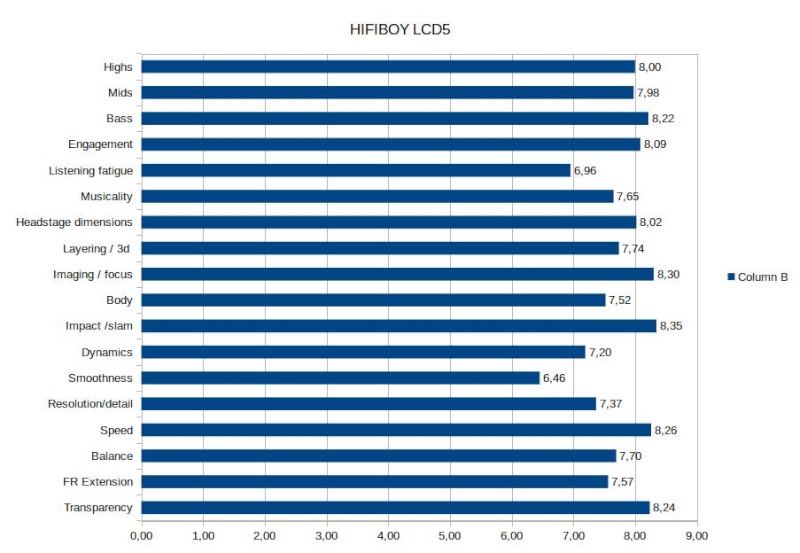
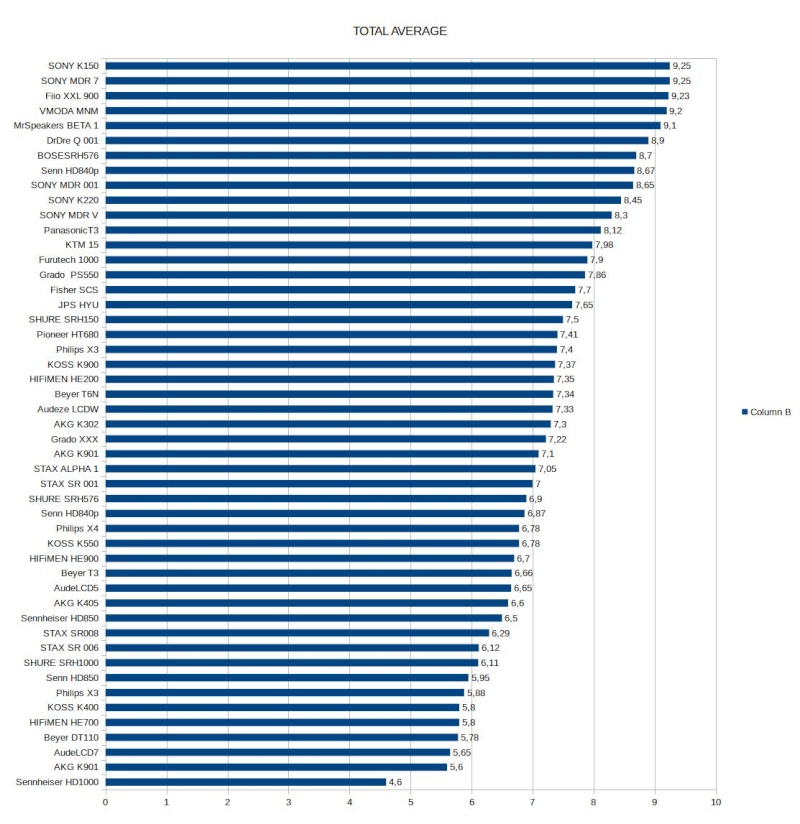

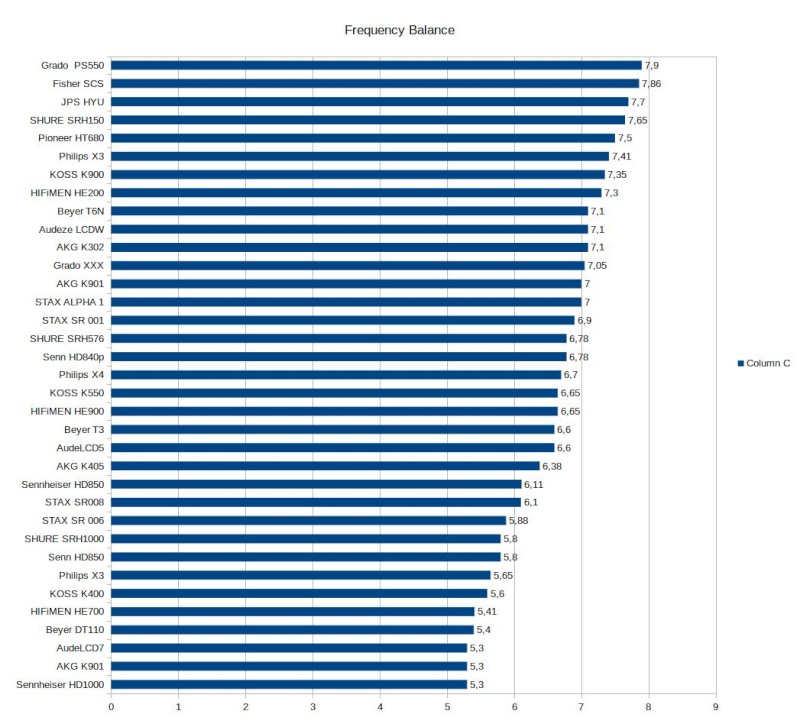
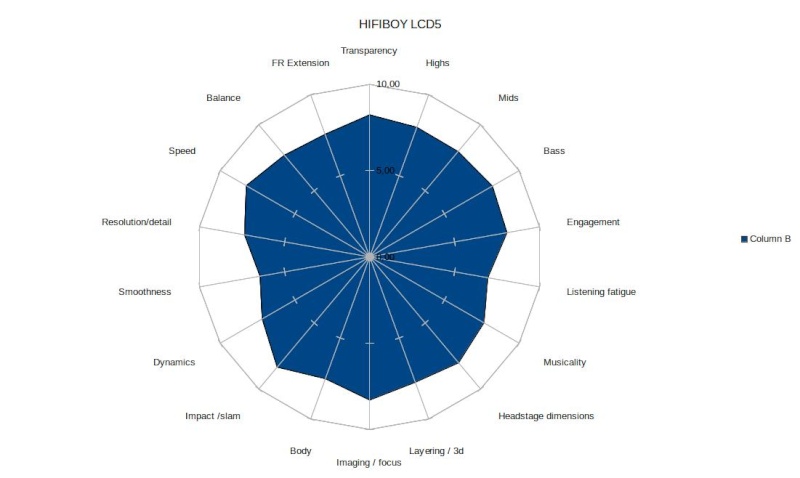
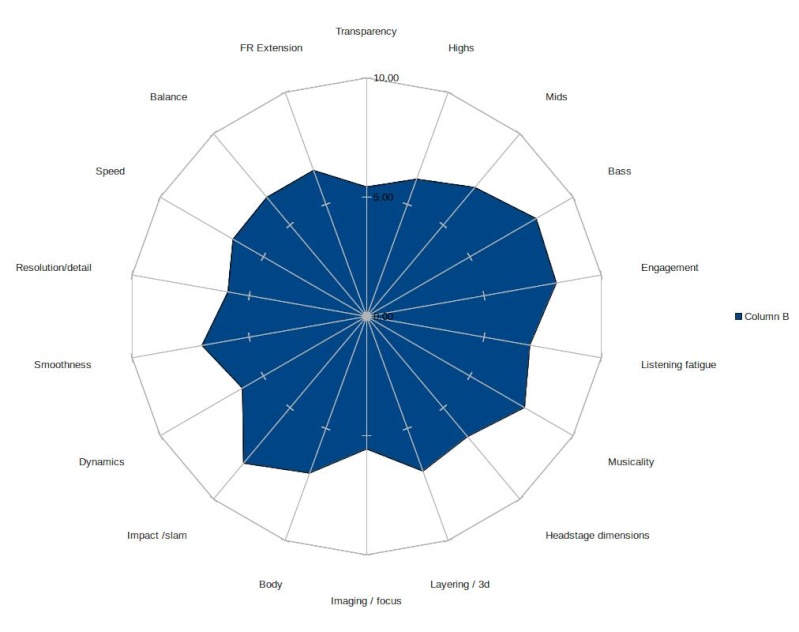
L'idée est de recueillir autant des informations possible sur la performance de
casque, telle que perçue par les utilisateurs. Déterminer la moyenne mathematique et également les différents graphiques selon les reçus de vote dans divers paramètres sélectionnés.
Les «bulletin scolaire» sont anonyme. Cela signifie que la communauté uni à exprimer une opinion sur le casque et sur le divers paramètres.
Des instructions simples:
- Faire le download du file .ods http://www.stereo-head.it/wp-content/up ... el-ENG.ods
- Renommez le file avec marque et le modèle du casque (par exemple en renommant le file Sennheiser HD600)
- Procéder au vote par (1 à 10) des différents paramètres. Si il ya des doutes sur les termes, il ya le mini-guide.
- Envoyez-le comme un attachement à headphone.statistics@gmail.com
-Utilisez un file.ods au .xls pour un seul casque. Autrement dit, pour 2 écouteurs 2 files, 3
Casque 3 fichiers ... Dans le même e-mail, vous pouvez envoyer plusieurs attachemants.
- En donnant les votes nous ne devrions pas penser au prix, mais seulement la qualité du son. La valeur sera décrit en futur cette statistique.
-Par référence nous pensons que le casque HD600 et DT880, vous pouvez travailler autour de la moyenne de 6,5 à 7,5.
Paramètres:
Transparency: A window to the music. Can we clearly see throug it?
( detailed, clear, not muddy. Wide flat frequency response, sharp time response, very low distortion and noise)
Extension: Extended frequency responce, presence of sub-bass and upper harmonics with absent or very low distorsion.
Balance: essentially tonal balance, the degree to which one aspect of the sonic spectrum is emphasized above the rest. Also channel balance, the relative level of the left and right stereo channels
Speed: Impulse response, fast transient. In fast passages everything is well defined.
Resolution: (detail, resolving, articulation) The ability of a component to reveal the subtle information that is fundamental to high fidelity sound. Easy to hear tiny details in the music in the original recording. Adequate high frequency response, sharp transient response and articulate bass.
Smooth / gentleness: Easy on the ears, not harsh. Flat frequency response, especially in the midrange. Lack of peaks and dips in the response. Every HP can be easy listening smooth, but often at the expense of detail retrival. In this parameter we have to judge how much a Headphone can be detailed and smooth at the same time, detailed without being harsh or sibilant or hot.
Dynamic: Ability to easily reproduce the variations in sound volume in the song. For example, from pianissimo to a full orchestra. "reproduce easily dynamics" is not synonymous of impact or slam (parameters that will follow), In judging this parameter we focus on ease and fluidity with which these “jumps” are executed. With very good dynamics there is a sense effortless. Obviously, considering an adequate amplification.
Impact/slam : The phisycal perception of power that the HP can give us. The more is speaker like, the better it is. (often a good HP near 100 Hz)
Body: Fullness of sound, can be even an emphasis on mid-bass or upper bass. (around 200-300 Hz) If this fullness does not overwhelm the mids clearness, the judgement should be high.
Imaging: Instruments or voices perceived in a well defined location, with particular attention on focus.
Layering / tridimensionality: the way they are distinct and far between the various levels of sound. You can hear the orchestra as developed in depth and width from near to far. It's not just a matter of “size” but also of well distinctions.
Headstage dimension: Just judge dimensions, extension, in depth lateral height.
Musicality: It's too subjective... everyone has his own notion of musicality, but you know what's your's. With that headphone you just think about the music. Everything it's OK. Pleasant.
Listening fatigue: If you do not feel tired after hours of listening, the judgment should be high.
Engagement: Funny Headpohone to listen to. Not Boring.
Bass: Quality and quantity of bass (0-200 Hz)
Mids: Quality and quantity of mids (200-2000 Hz)
Highs: Quality and quantity of Highs (2000-20000 Hz
examples






